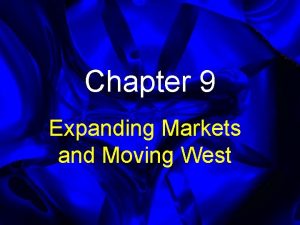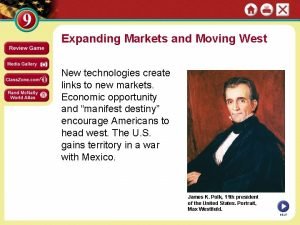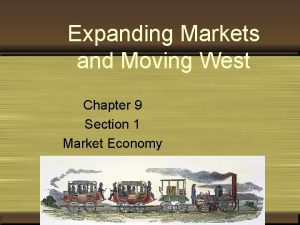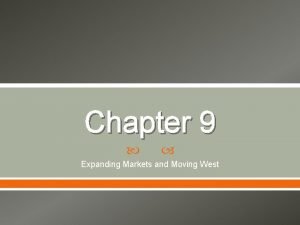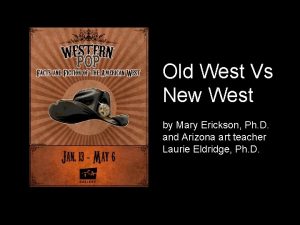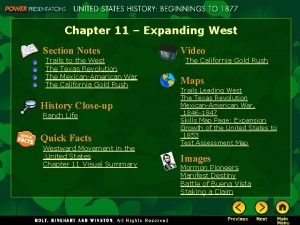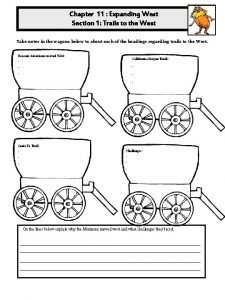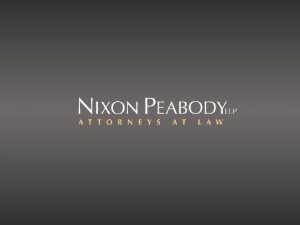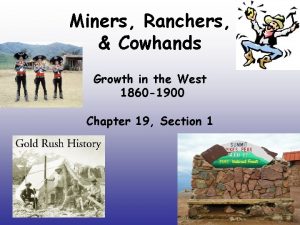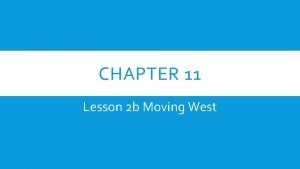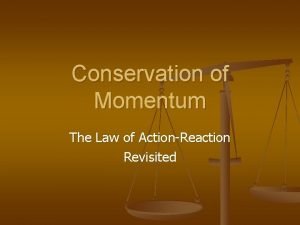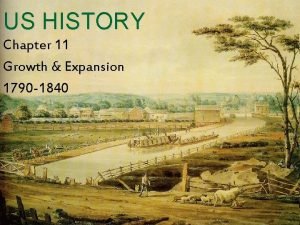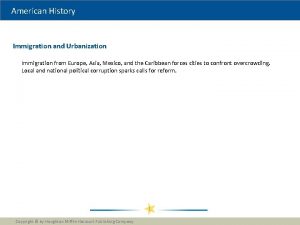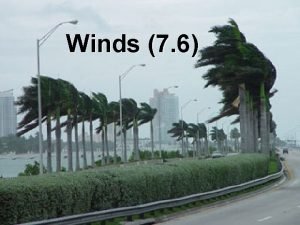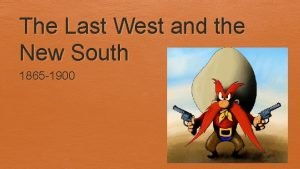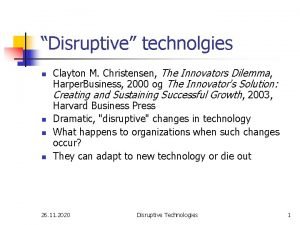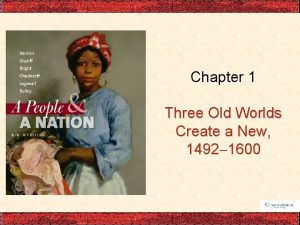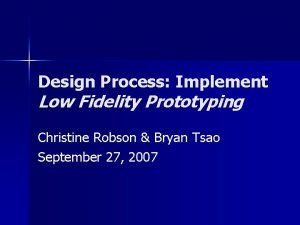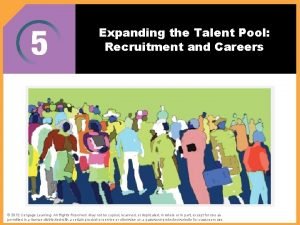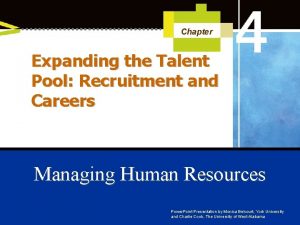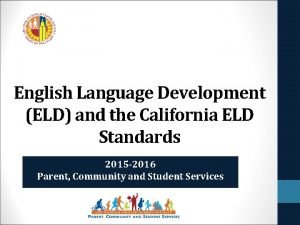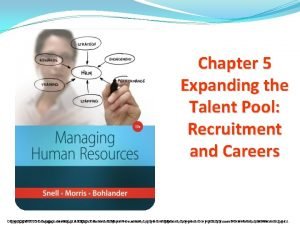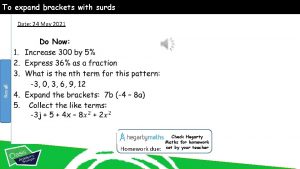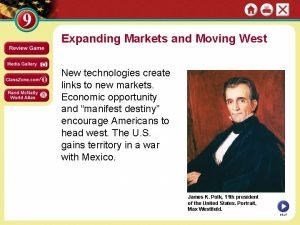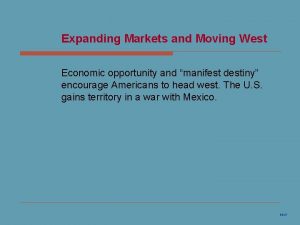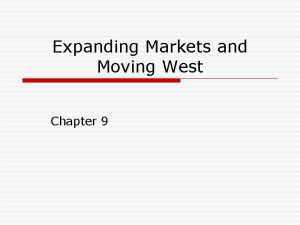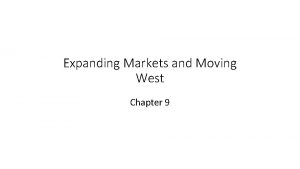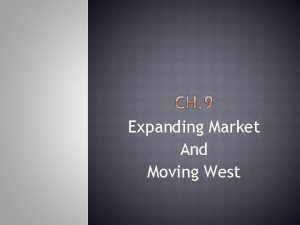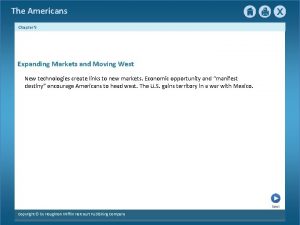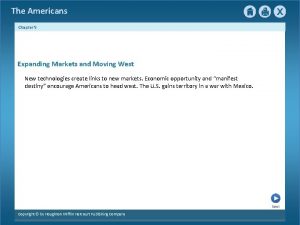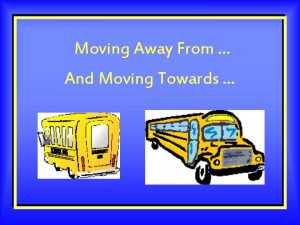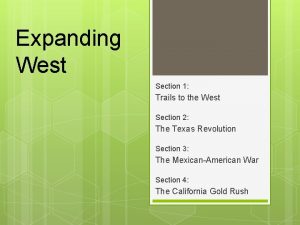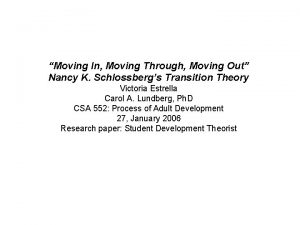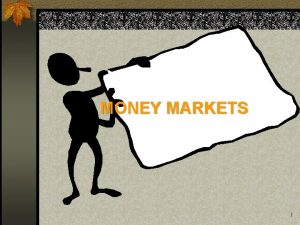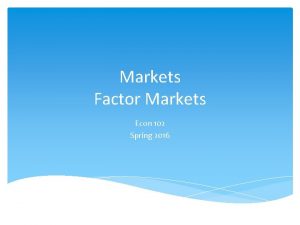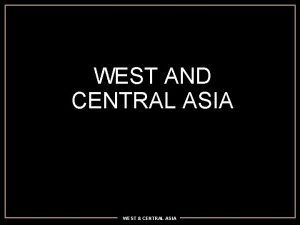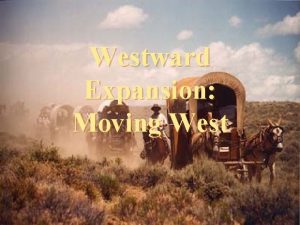Expanding Markets and Moving West New technologies create































- Slides: 31

Expanding Markets and Moving West New technologies create links to new markets. Economic opportunity and “manifest destiny” encourage Americans to head west. The U. S. gains territory in a war with Mexico. James K. Polk, 11 th president of the United States. Portrait, Max Westfield. NEXT

Expanding Markets and Moving West SECTION 1 The Market Revolution SECTION 2 Manifest Destiny SECTION 3 Expansion in Texas SECTION 4 The War with Mexico NEXT

Section 1 The Market Revolution Technological changes create greater interaction and more economic diversity among the regions of the nation. NEXT

SECTION 1 The Market Revolution U. S. Markets Expand Changing Economic Activities • Early 1800 s farm families self-sufficient; only buy what cannot make • Mid-century farmers begin specialization—raise 1 or 2 cash crops • Market revolution—people buy and sell goods rather than make them The Entrepreneurial Spirit • Capitalism—private control of means of production, used for profit • Business capital (money, property, machines) fuels growing economy • Entrepreneurs invest own money in new industries; great loss, profit Continued. . . NEXT

SECTION 1 continued U. S. Markets Expand New Inventions • Inventor-entrepreneurs develop new products • Charles Goodyear creates vulcanized rubber in 1839 • Elias Howe patents sewing machine; I. M. Singer adds foot treadle • Factory production of clothing now possible; prices drop by over 75% Image Impact on Household Economy • Farmers begin using mechanized farm equipment; boost industry output • Technology lowers cost of factory items; workers become consumers NEXT

SECTION 1 The Economic Revolution Impact on Communication • 1837, Samuel F. B. Morse develops electromagnetic telegraph: - messages tapped in code, carried by copper wire - businesses, railroads transmit information Continued. . . NEXT

SECTION 1 continued The Economic Revolution Impact on Transportation • 1807, Robert Fulton’s steamboat goes 150 miles up Hudson in 32 hours • By 1830 steamboats on western rivers cut freight costs, speed travel • Water transport key for moving heavy machinery, raw materials • Erie Canal heavily used, lowers cost; dozens of canals follow • Canals connect Midwest farmers to Northeast and world markets Image Continued. . . NEXT

SECTION 1 continued The Economic Revolution Emergence of Railroads • 1840 s, shipping by railroad much costlier than by canal • Railroads faster, operate in winter, go inland • Early train travel uncomfortable for passengers • By 1850 s, railroads expand, cost drops, safety increased NEXT

SECTION 1 New Markets Link Regions Effect of Regional Links • Improved transportation, communication make regions interdependent • By 1838 National Road extends from Cumberland, MD to Springfield, IL • Growing links lead to development of regional specialties Southern Agriculture • Most of South agricultural; relies on cotton, tobacco, rice • South lacks capital for factories; money tied up in land, slave Continued. . . NEXT

SECTION 1 continued New Markets Link Regions Northeast Shipping and Manufacturing • Canals, railroads turn Northeast into center of American commerce • New York City central link between U. S. farms and European markets • Great rise in manufacturing: more, better, less expensive goods Map Midwest Farming • John Deere invents steel plow; farmers replace oxen with horses • Cyrus Mc. Cormick invents mechanical reaper; 1 farmer can do work of 5 • Farmers shift from subsistence farming to growing cash crops NEXT

Section 2 Manifest Destiny Americans move west, energized by their belief in the rightful expansion of the United States from the Atlantic to the Pacific. NEXT

SECTION 2 Manifest Destiny The Frontier Draws Settlers American Mission • Before 1840, few Americans go to Louisiana Territory; many do after • Manifest destiny—belief that U. S. destined to expand to Pacific Ocean Map Attitudes Toward the Frontier • Many settlers try fresh start in West after panic of 1837 • Land for farming, speculation important for building prosperity • Merchants seeking new markets follow farmers, miners • Oregon Territory harbors expand trade with Asia; serve Pacific fleet NEXT

SECTION 2 Settlers and Native Americans Effects on Native American Communities • Most Native Americans maintain own traditions even if forced to move • Some assimilate into white culture; a few fight to keep whites out The Black Hawk War Image • In 1830 s, settlers in Illinois, Iowa pressure natives to go west • Chief Black Hawk leads rebellion in Illinois, Wisconsin Territory • Sauk, Fox tribes defeated, forcibly moved west of the Mississippi Continued. . . NEXT

SECTION 2 continued Settlers and Native Americans Middle Ground • Middle ground is area not dominated by Native Americans or settlers • Good relations where settlers need Native American trading partners • Middle ground west of Mississippi, result of 1830 Indian Removal Act Continued. . . NEXT

SECTION 2 continued Settlers and Native Americans Fort Laramie Treaty • Small numbers of displaced natives fight settlers moving west • 1851 Treaty of Fort Laramie between U. S. government, native nations - Native Americans get control of Central Plains - promise not to attack settlers - U. S. pledges to honor boundaries • Settlers increase, deplete buffalo, elk; U. S. violates treaty NEXT

SECTION 2 Trails West The Santa Fe Trail • Thousands trek west on old Native American trails, new routes • Santa Fe Trail—busy trade route; Independence, MO to Santa Fe, NM • First 150 miles wagons go alone, then band together for protection Map The Oregon Trail • 1836, settlers go to Oregon, prove wagons can go into Northwest • Oregon Trail—trail from Independence, MO to Portland, OR • Pioneers use Conestoga wagons, push handcarts; trip takes months Continued. . . NEXT

SECTION 2 continued Trails West The Mormon Migration • Joseph Smith forms Church of Jesus Christ of Latter-day Saints in NY • Mormons—religious group, settles in Illinois; clashes over polygamy • Brigham Young, Smith’s successor, leads Mormons outside U. S. - settle near Great Salt Lake, Utah Image Resolving Territorial Disputes • 1842, Webster-Ashburton Treaty settles border in East, Midwest • “Fifty-Four Forty or Fight!” slogan calls for annexation of Oregon • 1846, U. S. , Britain extend boundary west along 49 th parallel NEXT

Section 3 Expansion in Texas Mexico offers land grants to American settlers, but conflict develops over religion and other cultural differences, and the issue of slavery. NEXT

SECTION 3 Expansion in Texas Americans Settle in the Southwest The Mission System • Under Spanish, a few thousand Mexican settlers in present-day Texas • Spanish use Roman Catholic missions to convert Native Americans • Mexico offers mission lands to government officials, ranchers The Impact of Mexican Independence • Mexico encourages trade between U. S. and northern provinces • Native American groups threaten scattered Mexican settlements Continued. . . NEXT

SECTION 3 continued Americans Settle in the Southwest Mexico Invites U. S. Settlers • To protect territory, Mexico encourages U. S. farmers to go to Texas • Offers land grants to empresarios (agents) who sell land cheaply • Until 1830 s, Anglo settlers live as naturalized Mexican citizens Austin in Texas • Stephen F. Austin, successful empresario, establishes colony in 1821 • Old Three Hundred get 177 farming acres or 4, 428 grazing acres • U. S. wants lands south to Rio Grande; Mexico refuses to sell Texas NEXT

SECTION 3 Texas Fights for Independence “Come to Texas” • Cultural differences arise between Anglos and Mexico: - Anglos speak English, not Spanish - Southerners bring slaves; Mexico abolished slavery • In 1830 s, Anglos greatly outnumber Tejanos • Mexican president Antonio López de Santa Anna imprisons Austin - revokes local powers; rebellions erupt, including Texas Revolution “Remember the Alamo!” Image • Santa Anna marches to Texas; Austin tells Texans to arm themselves • Santa Anna storms Alamo, old mission; all 187 U. S. defenders killed Continued. . . NEXT

SECTION 3 continued Texas Fights for Independence The Lone Star Republic • Sam Houston defeats, captures Santa Anna at Battle of San Jacinto • Treaty of Velasco grants independence to Texas (April 1836) • Houston becomes president of the Republic of Texas Map Texas Joins the Union • 1838, Houston invites U. S. to annex, or incorporate, Texas • South favors, North opposes annexation; Texas becomes state in 1845 NEXT

Section 4 The War with Mexico Tensions over the U. S. annexation of Texas leads to war with Mexico, resulting in huge territorial gains for the United States. NEXT

SECTION 4 The War with Mexico Polk Urges War “Polk the Purposeful” • President James K. Polk favors war with Mexico - believes U. S. will get Texas, New Mexico, California Slidell’s Rejection • Polk sends John Slidell to buy Southwest, negotiate Texas border • Santa Anna ousted; Mexican government unstable, ignores Slidell • Polk orders General Zachary Taylor to blockade the Rio Grande Continued. . . NEXT

SECTION 4 continued Polk Urges War Sectional Attitudes Toward War • South favors war to extend slavery, increase its power in Congress • North opposes war, fears spread of slavery, Southern control of U. S. NEXT

SECTION 4 The War Begins Polk Provokes War • U. S. repeatedly violates Mexico’s territorial rights • Mexican, U. S. soldiers skirmish near Matamoros; 9 Americans killed • Polk sends war message to Congress, withholds facts • Congress approves war, stifles opposition Kearny Marches West • Polk orders Colonel Stephen Kearny to march to Santa Fe • New Mexico surrenders to U. S. without a fight Image Continued. . . NEXT

SECTION 4 continued The War Begins The Republic of California • 1830 s, 12, 000 Mexican settlers in California; 1840 s, 500 Americans • John C. Frémont proclaims Republic of California in 1846 • Frémont joined by Kearny, Commodore John D. Sloat’s naval expedition The War in Mexico • U. S. has many military victories; Mexican troops have poor leaders • Invasion of Mexico led by generals Zachary Taylor, Winfield Scott • Polk helps Santa Anna regain power, but Santa Anna fights U. S. Map Image NEXT

SECTION 4 America Gains the Spoils of War The Treaty of Guadalupe Hidalgo • U. S. and Mexico sign Treaty of Guadalupe Hidalgo in 1848 -Texas border set at Rio Grande - Mexico cedes western lands for $15 million - guarantees rights of Mexicans living in territories • War enlarges U. S. territory by about one-third • Franklin Pierce authorizes 1853 Gadsden Purchase, sets final border Chart Taylor’s Election in 1848 • Democrats divided over extension of slavery • Whig nominee, war hero Zachary Taylor easily wins election NEXT

SECTION 4 The California Gold Rush The Rush Begins • 1848, gold discovered at Sutter’s Mill in California Sierra Nevadas • San Francisco residents abandon city to pan for gold • Gold rush, or migration of prospectors to California in 1849 • Forty-niners, gold prospectors, come from Asia, South America, Europe Image Continued. . . NEXT

SECTION 4 continued The California Gold Rush Impact of Gold Fever • San Francisco becomes supply center for miners, major port Gold Rush Brings Diversity • By 1849, California’s population exceeds 100, 000 • Chinese, free blacks, Mexicans migrate in large numbers • Slavery permitted until outlawed by 1849 constitutional convention • California joins Union in 1850 NEXT

This is the end of the chapter presentation of lecture notes. Click the HOME or EXIT button.
 Chapter 9 expanding markets and moving west
Chapter 9 expanding markets and moving west Expanding markets and moving west
Expanding markets and moving west Chapter 9 expanding markets and moving west
Chapter 9 expanding markets and moving west Chapter 9 expanding markets and moving west
Chapter 9 expanding markets and moving west Old west vs new west
Old west vs new west Expanding west section 3
Expanding west section 3 Expanding west section 3
Expanding west section 3 Nomura connecting markets east & west
Nomura connecting markets east & west Jika noel(create(q)) adalah 0, maka front(create(q)) adalah
Jika noel(create(q)) adalah 0, maka front(create(q)) adalah Historic tax credits 101
Historic tax credits 101 East is east and west is west
East is east and west is west Moving west
Moving west Chapter 11 lesson 2 moving west
Chapter 11 lesson 2 moving west Action reaction and momentum conservation
Action reaction and momentum conservation Lesson 2 moving west
Lesson 2 moving west Immigration and urbanization new technologies lesson 4
Immigration and urbanization new technologies lesson 4 What is the horizontal movement of air called
What is the horizontal movement of air called What creates wind
What creates wind Noord, oost, zuid west wijzer
Noord, oost, zuid west wijzer The last west and the new south
The last west and the new south New disruptive technologies 2021
New disruptive technologies 2021 New disruptive technologies
New disruptive technologies Let's write a letter
Let's write a letter Sap hybris extensions
Sap hybris extensions Three old worlds create a new
Three old worlds create a new Create a new profile
Create a new profile Expanding the talent pool recruitment and careers
Expanding the talent pool recruitment and careers Identify a warning sign of a weak talent bench
Identify a warning sign of a weak talent bench Expanding brackets and solving equations worksheet
Expanding brackets and solving equations worksheet Site:slidetodoc.com
Site:slidetodoc.com Expanding the talent pool recruitment and careers
Expanding the talent pool recruitment and careers Expanding and simplifying surds
Expanding and simplifying surds
